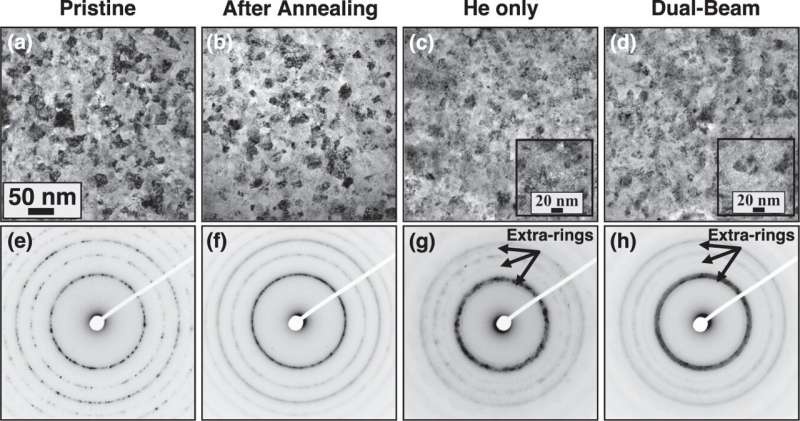This article has been reviewed according to Science X's editorial process and policies. Editors have highlighted the following attributes while ensuring the content's credibility:
fact-checked
peer-reviewed publication
trusted source
proofread
Team develops alloy to boost fusion energy

A newly developed tungsten-based alloy that performs well in extreme environments similar to those in fusion reactor prototypes may help harness fusion energy.
"The new alloy shows promising resistance to irradiation resistance and stability under the high temperatures and extreme irradiation environments used to represent a fusion-reactor environment," said Osman El Atwani, a staff scientist at Los Alamos National Laboratory.
"The development of this alloy, and the agreement between modeling and experimentation that it represents, points the way toward the development of further useful alloys, an essential step in making fusion power generation more robust, cost-effective, economically predictable and attractive to investors."
As fusion energy concepts move closer to the real world, solving the materials challenge is imperative. The encouraging results indicate that a design paradigm, as described by El Atwani and his collaborators, and high entropy alloys may be ready to play their role in harnessing the promise of fusion.
El Atwani was the principal investigator for the project, which involved several national and international institutions. Their results were published in May in Nature Communications.
The fusion materials challenge
Clean energy production through fusion requires materials that can withstand the harsh conditions—high temperatures, irradiation (exposure to high energy neutron radiation and helium particle fluxes) and stress—associated with fusion reactions that burn hotter than the sun.
El Atwani and his collaborators developed a nanocrystalline high entropy alloy—an alloy made of five or more elements, with a crystalline form at the nanoscale (atomic) level. Tungsten, a long-studied element of choice for plasma-facing components, is the main element in the alloy.
Unfortunately, current tungsten materials are limited in their viability as plasma-facing components because the material degrades and deforms under fusion conditions. To develop materials more suitable for fusion, the research team used calculations of thermophysical properties, advanced computational methods, and simulations performed at multiple institutions including Los Alamos, the United Kingdom Atomic Energy Authority, Clemson University and the University of Warsaw.
Ultimately, the element hafnium was chosen for the alloy mix based on performance predicted by the modeling and simulations.
Fabrication and experimentation
After fabricating films of the alloy in the Center for Integrated Nanotechnologies at Los Alamos, one version of the material was irradiated at Argonne National Laboratory. Another version was irradiated at the Ion Beam Materials Laboratory at Los Alamos. Advanced techniques, including in-situ transmission electron microscopy, show that the alloy held up well under these harsh experimental conditions, which replicate a fusion-nuclear-energy prototype.
"The selected compositions of this material system exhibit the best irradiation resistance among all alloys tested at similar conditions and setups," said Enrique Martinez, a materials scientist with Clemson University. "Those results align with our modeling, which greatly minimized the set of experiments necessary to assess the material's performance."
Such alloys can also be synthesized in amorphous forms, a type of structure where the atoms in materials don't line up over a long distance, as with crystalline structures. In related research by a Los Alamos team, the addition of hafnium in amorphous alloys introduced high stability under irradiation and annealing, a heat treatment experienced in fusion settings. That success, led by principal investigator El Atwani and Los Alamos postdoctoral researcher Matheus Tunes, was recently described in Applied Materials Today.
"These projects constitute early-technology readiness level work, and bulk manufacturing of the materials and further experiments are necessary to qualify them as plasma-facing components or structural nuclear fusion materials," said El Atwani. "However, the overall work we've accomplished with these alloys, with high throughput simulation and experimental outputs, represents a materials design protocol for the future design and assessment of new alloys. These results will help us select materials to advance the technology readiness level."
More information: O. El Atwani et al, A quinary WTaCrVHf nanocrystalline refractory high-entropy alloy withholding extreme irradiation environments, Nature Communications (2023). DOI: 10.1038/s41467-023-38000-y
M.A. Tunes et al, Perspectives on novel refractory amorphous high-entropy alloys in extreme environments, Applied Materials Today (2023). DOI: 10.1016/j.apmt.2023.101796















